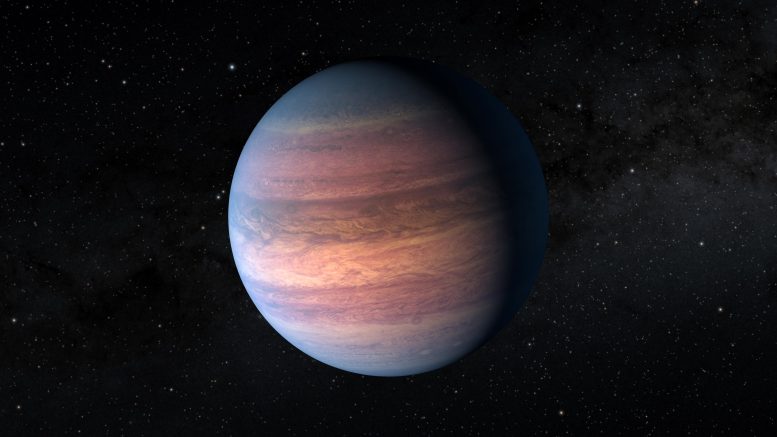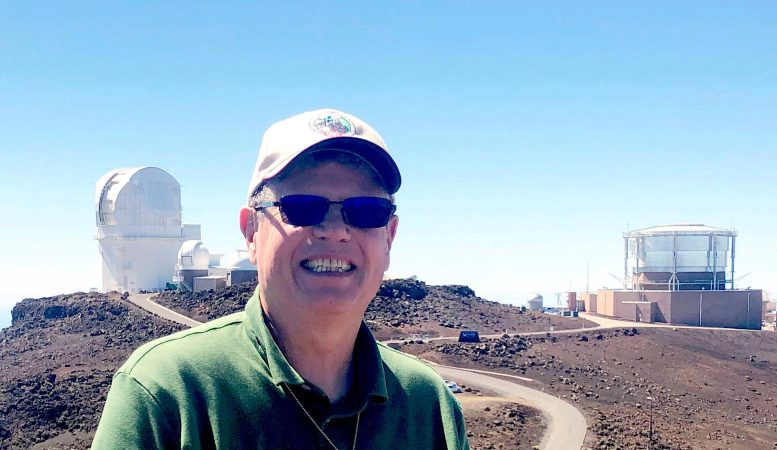
This illustration depicts a Jupiter-like exoplanet called TOI-2180 b. It was discovered in data from NASA’s Transiting Exoplanet Survey Satellite. Credit: NASA/JPL-Caltech/R. Hurt
Tom Jacobs of Bellevue, Washington, loves treasure hunts. Since 2010, the former U.S. naval officer has participated in online volunteer projects that allow anyone who is interested — “citizen scientists” — to look through NASA telescope data for signs of exoplanets, planets beyond our solar system.
Now, Jacobs has helped discover a giant gaseous planet about 379 light-years from Earth, orbiting a star with the same mass as the Sun. The Jupiter-size planet is special for astronomers because its 261-day year is long compared to many known gas giants outside our solar system. The result also suggests the planet is just a bit farther from its star than Venus is from the Sun. The finding was published in the Astronomical Journal and presented at an American Astronomical Society virtual press event on January 13.
Uncovering this planet and pinning down its size and mass required a large collaboration between professional astronomers and citizen scientists like Jacobs. To track the planet, they engaged in “a global uniting effort, because we all need to go after it together to keep eyes on this particular planet,” said Paul Dalba, astronomer at the University of California, Riverside, and lead author of the study.
“Discovering and publishing TOI-2180 b was a great group effort demonstrating that professional astronomers and seasoned citizen scientists can successfully work together,” Jacobs said. “It is synergy at its best.”
How the discovery happened
The signature for the newly discovered planet was hiding in data from NASA’s Transiting Exoplanet Survey Satellite, or TESS. Using TESS data, scientists look for changes in brightness of nearby stars, which could indicate the presence of orbiting planets.
Jacobs is part of a group of citizen scientists who look at plots of TESS data, showing the change in a star’s brightness over time, in search of new planets. While professional astronomers use algorithms to scan tens of thousands of data points from stars automatically, these citizen scientists use a program called LcTools, created by Alan R. Schmitt, to inspect telescope data by eye. That’s why Jacobs’ group, which includes several citizen scientists and two veteran astronomers, calls themselves the Visual Survey Group. Many of them met while working on Planet Hunters, a NASA-funded citizen science project through Zooniverse that focused on data from NASA’s Kepler spacecraft.
On February 1, 2020, Jacobs happened to notice a plot showing starlight from TOI-2180 dim by less than half a percent and then return to its previous brightness level over a 24-hour period, which may be explained by an orbiting planet that is said to “transit” as it passes in front of the star from our point of view. By measuring the amount of light that dims as the planet passes, scientists can estimate how big the planet is and, in combination with other measurements, its density. But a transit can only be seen if a star and its planet line up with telescopes looking for them.

Tom Jacobs, a citizen scientist who collaborates with professional scientists to look for exoplanets, at the Haleakalā High Altitude Observatory Site in Hawaii. Credit: Tom Jacobs
A graph showing starlight over time is called a “light curve.” The Visual Survey Group alerted two professional scientist collaborators — Paul Dalba at the University of California, Riverside, and Diana Dragomir, assistant professor at the University of New Mexico, that this light curve was potentially interesting.
“With this new discovery, we are also pushing the limits of the kinds of planets we can extract from TESS observations,” Dragomir said. “TESS was not specifically designed to find such long-orbit exoplanets, but our team, with the help of citizen scientists, are digging out these rare gems nonetheless.”
Computer algorithms used by professional astronomers are designed to search for planets by identifying multiple transit events from a single star. That’s why citizen scientists’ visual inspection is so useful when there is only one transit available. Since this is the only instance of the TOI-2180 b star dimming in this dataset, it is called a “single transit event.”
“The manual effort that they put in is really important and really impressive, because it’s actually hard to write code that can go through a million light curves and identify single transit events reliably,” Dalba said. “This is one area where humans are still beating code.”
But how could the team rule out other explanations for the brief dip in starlight? Could they be sure they had found a planet? They would need follow-up observations.
Fortunately, Dalba was able to recruit the Automated Planet Finder Telescope at Lick Observatory in California. “I use that telescope to measure the wobble of the star to then determine how massive this planet is, if it is a planet at all,” he said. The research team also used the Keck I telescope at the W. M. Keck Observatory in Hawaii to perform some of these measurements when Lick Observatory was threatened by wildfires.
With 27 hours of observations spread over more than 500 days, Dalba and colleagues observed the planet’s gravitational tug on the star, which allowed them to calculate the planet’s mass and estimate a range of possibilities for its orbit. Still, they wanted to observe the planet’s transit when it came back around to confirm the orbit. Unfortunately, finding a second transit event was going to be difficult because there was so much uncertainty about when the planet would cross the face of its star again.
Dalba pressed on, and organized an observing campaign including both professional astronomers and citizen scientists using telescopes at 14 sites across three continents in August 2020. To support the campaign, Dalba camped for five nights in California’s Joshua Tree National Park and looked for the transit with two portable amateur telescopes. The collaborative effort yielded 55 datasets over 11 days.
Ultimately, none of these telescopes detected the planet with confidence. Still, the lack of a clear detection in this time period put a boundary on how long the orbit could be, indicating a period of about 261 days. Using that estimate, they predict TESS will see the planet transit its star again in February 2022.
About the planet
TOI-2180 b is almost three times more massive than Jupiter but has the same diameter, meaning it is more dense than Jupiter. This made scientists wonder whether it formed in a different way than Jupiter.
Another clue about the planet’s formation could be what’s inside it. Through computer models they determined that the new planet may have as much as 105 Earth masses worth of elements heavier than hydrogen and helium. “That’s a lot,” says Dalba. “That’s more than what we suspect is inside Jupiter.”
Astronomers still have much to learn about the range of planets that are out there. About 4,800 exoplanets have been confirmed, but there are thought to be billions of planets in our galaxy. The new finding indicates that among giant planets, some have many more heavy elements than others.
In our solar system, gigantic Jupiter orbits the Sun every 12 years; for Saturn, a “year” is 29 years. We don’t have giant planets like TOI-2180 b between the Earth and Sun. But outside the solar system, astronomers have found dozens of exoplanets that are even bigger than Jupiter and orbit much closer to their stars, even closer than the orbit of Mercury.
With an average temperature of about 170 degrees Fahrenheit, TOI-2180 b is warmer than room temperature on Earth, and warmer than the outer planets of our solar system including Jupiter and Saturn. But compared to the array of transiting giant exoplanets that astronomers have found orbiting other stars, TOI-2180 b is abnormally chilly.
“It’s a nice stepping stone in between most giant exoplanets we’ve found, and then really cold Jupiter and Saturn,” Dalba said.
What’s next
When TESS observes the star again in February, Dalba and the citizen scientists are eager to get the data and dive back in. If they find the planet’s signature, confirming the 261-day period, that would give more meaning to the data from their global campaign to find it in 2020.
NASA’s James Webb Space Telescope, which launched on December 25, could potentially observe this planet and its atmosphere. But there’s another reason Dalba is excited about Webb’s capabilities. Given that in our own solar system, Jupiter has rings and moons, Webb could be used to look for the presence of small objects orbiting TOI-2180 b.
So far, no rings or moons have been found outside of our solar system with certainty, but one reason could be that many exoplanets are found very close to their star, whose gravity might strip such objects away. TOI-2180 b, located at a farther distance from its host star, might present an interesting opportunity for such a search. “I think this is a fun system for that later on in the future,” Dalba said.
When he’s not pursuing his planet-hunting hobby, Jacobs, the citizen scientist, works with nonprofits that help people with disabilities find employment in their communities.
The Visual Survey Group members “devote many hours each day surveying the data out of pure joy and interest in furthering science,” said Jacobs. Collectively, the team has co-authored more than 68 peer-reviewed science papers, including the discovery of transiting “exocomets” or comets outside the solar system crossing the face of a star.
“We love contributing to science,” Jacobs said. “And I love this type of surveying, knowing that one is in new undiscovered territory not seen by any humans before.”
Reference: “The TESS-Keck Survey. VIII. Confirmation of a Transiting Giant Planet on an Eccentric 261 Day Orbit with the Automated Planet Finder Telescope” by Paul A. Dalba, Stephen R. Kane, Diana Dragomir, Steven Villanueva Jr., Karen A. Collins, Thomas Lee Jacobs, Daryll M. LaCourse, Robert Gagliano, Martti H. Kristiansen, Mark Omohundro, Hans M. Schwengeler, Ivan A. Terentev, Andrew Vanderburg, Benjamin Fulton, Howard Isaacson, Judah Van Zandt, Andrew W. Howard, Daniel P. Thorngren, Steve B. Howell, Natalie M. Batalha, Ashley Chontos, Ian J. M. Crossfield, Courtney D. Dressing, Daniel Huber, Erik A. Petigura, Paul Robertson, Arpita Roy, Lauren M. Weiss, Aida Behmard, Corey Beard, Casey L. Brinkman, Steven Giacalone, Michelle L. Hill, Jack Lubin, Andrew W. Mayo, Teo Mocnik, Joseph M. Akana Murphy, Alex S. Polanski, Malena Rice, Lee J. Rosenthal, Ryan A. Rubenzahl, Nicholas Scarsdale, Emma V. Turtelboom, Dakotah Tyler, Paul Benni, Pat Boyce, Thomas M. Esposito, E. Girardin, Didier Laloum, Pablo Lewin, Christopher R. Mann, Franck Marchis, Richard P. Schwarz, Gregor Srdoc, Jana Steuer, Thirupathi Sivarani, Athira Unni, Nora L. Eisner, Tara Fetherolf, Zhexing Li, Xinyu Yao, Joshua Pepper, George R. Ricker, Roland Vanderspek, David W. Latham, S. Seager, Joshua N. Winn, Jon M. Jenkins, Christopher J. Burke, Jason D. Eastman, Michael B. Lund, David R. Rodriguez, Pamela Rowden, Eric B. Ting and Jesus Noel Villaseñor, 13 January 2022, The Astronomical Journal.
DOI: 10.3847/1538-3881/ac415b
More About Citizen Science
NASA has a wide variety of citizen science collaborations across topics ranging from Earth science to the Sun to the wider universe. Anyone in the world can participate. Check out the latest opportunities at science.nasa.gov/citizenscience.
About TESS
TESS is a NASA Astrophysics Explorer mission led and operated by MIT in Cambridge, Massachusetts, and managed by NASA’s Goddard Space Flight Center. Additional partners include Northrop Grumman, based in Falls Church, Virginia; NASA’s Ames Research Center in California’s Silicon Valley; the Center for Astrophysics | Harvard & Smithsonian in Cambridge, Massachusetts; MIT’s Lincoln Laboratory; and the Space Telescope Science Institute in Baltimore. More than a dozen universities, research institutes, and observatories worldwide are participants in the mission.
The National Science Foundation Astronomy and Astrophysics Postdoctoral Fellowship Program contributed support to this study.
Article From & Read More ( Citizen Scientists Discover Giant Jupiter-Like Planet in NASA TESS Data - SciTechDaily )https://ift.tt/3nugaDe
Science
No comments:
Post a Comment